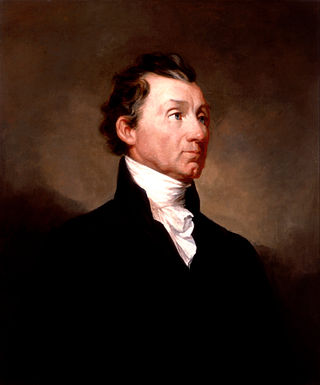
The United States Department of Transportation is one of the executive departments of the U.S. federal government. It is headed by the secretary of transportation, who reports directly to the president of the United States and is a member of the president's Cabinet.

Abraham Alfonse Albert Gallatin was a Genevan–American politician, diplomat, ethnologist and linguist. Often described as "America's Swiss Founding Father", he was a leading figure in the early years of the United States, helping shape the new republic's financial system and foreign policy. Gallatin was a prominent member of the Democratic-Republican Party, represented Pennsylvania in both chambers of Congress, and held several influential roles across four presidencies, most notably as the longest serving U.S. Secretary of the Treasury. He is also known for his contributions to academia, namely as the founder of New York University and cofounder of the American Ethnological Society.

The Intracoastal Waterway (ICW) is a 3,000-mile (4,800 km) inland waterway along the Atlantic and Gulf of Mexico coasts of the United States, running from Massachusetts southward along the Atlantic Seaboard and around the southern tip of Florida, then following the Gulf Coast to Brownsville, Texas. Some sections of the waterway consist of natural inlets, saltwater rivers, bays, and sounds, while others are artificial canals. It provides a navigable route along its length without many of the hazards of travel on the open sea.

The Potomac Company was created in 1785 to make improvements to the Potomac River and improve its navigability for commerce. The project is perhaps the first conceptual seed planted in the minds of the new American capitalists in what became a flurry of transportation infrastructure projects, most privately funded, that drove wagon road turnpikes, navigations, and canals, and then as the technology developed, investment funds for railroads across the rough country of the Appalachian Mountains.

Tulpehocken Creek is a 39.5-mile-long (63.6 km) tributary of the Schuylkill River in southeastern Pennsylvania in the United States, and during the American Canal Age, once provided nearly half the length of the Union Canal linking the port of Philadelphia, the largest American city and the other communities of Delaware Valley with the Susquehanna basin and the Pennsylvania Canal System connecting the Eastern seaboard to Lake Erie and the new settlements of the Northwest Territory via the Allegheny, Monongahela, and Ohio Rivers at Pittsburgh.
Internal improvements is the term used historically in the United States for public works from the end of the American Revolution through much of the 19th century, mainly for the creation of a transportation infrastructure: roads, turnpikes, canals, harbors and navigation improvements. This older term carries the connotation of a political movement that called for the exercise of public spirit as well as the search for immediate economic gain. Improving the country's natural advantages by developments in transportation was, in the eyes of George Washington and many others, a duty incumbent both on governments and on individual citizens.
The Maysville Road veto occurred on May 27, 1830, when United States President Andrew Jackson vetoed a bill that would allow the federal government to purchase stock in the Maysville, Washington, Paris, and Lexington Turnpike Road Company, which had been organized to construct a road linking Lexington, Kentucky, to Maysville on the Ohio River, the entirety of which would be in the state of Kentucky. Its advocates regarded it as a part of the national Cumberland Road system. Congress passed a bill in 1830 providing federal funds to complete the project. Jackson vetoed the bill on the grounds that federal funding of intrastate projects of this nature was unconstitutional. He declared that such bills violated the principle that the federal government should not be involved in local economic affairs. Jackson also pointed out that funding for these kinds of projects interfered with paying off the national debt.

The Delaware and Hudson Railway (D&H) is a railroad that operates in the Northeastern United States. In 1991, after more than 150 years as an independent railroad, the D&H was purchased by the Canadian Pacific Railway (CP). CP, which would itself become part of Canadian Pacific Kansas City in 2023, operated D&H under its subsidiary Soo Line Corporation, which also operates Soo Line Railroad.

Delaware Route 1 (DE 1) is the longest numbered state highway in the U.S. state of Delaware. The route runs 102.63 mi (165.17 km) from the Maryland state line in Fenwick Island, Sussex County, where the road continues south into that state as Maryland Route 528 (MD 528), north to an interchange with Interstate 95 (I-95) in Christiana, New Castle County, where the roadway continues north as part of DE 7. Between Fenwick Island and Dover Air Force Base in Dover, Kent County, DE 1 is a multilane divided highway with at-grade intersections and occasional interchanges. The route heads north through the Delaware Beaches resort area along the Atlantic Ocean before it runs northwest through rural areas, turning north at Milford to continue to Dover. Upon reaching Dover, DE 1 becomes the Korean War Veterans Memorial Highway, a freeway that is partially tolled. Between Dover and Tybouts Corner, DE 1 parallels U.S. Route 13 (US 13), crossing over and featuring interchanges with it multiple times. Past Tybouts Corner, the freeway heads north parallel to DE 7 to the northern terminus of DE 1 in Christiana. DE 1 serves as the main north-south state highway in Delaware, connecting the Delaware Beaches with the Dover and Wilmington areas.

The Regional Plan Association is an independent, not-for-profit regional planning organization, founded in 1922, that focuses on recommendations to improve the quality of life and economic competitiveness of a 31-county New York–New Jersey–Connecticut region in the New York metropolitan area. Headquartered in New York City, it has offices in Princeton, New Jersey, and Stamford, Connecticut.

The Pennsylvania Canal, sometimes known as the Pennsylvania Canal system, was a complex system of transportation infrastructure improvements, including canals, dams, locks, tow paths, aqueducts, and viaducts. The canal was constructed and assembled over several decades beginning in 1824, the year of the first enabling act and budget items.

The Lynn Canal Highway, or Juneau Access Road, is a proposed road between Skagway and City and Borough of Juneau, the capital of the U.S. state of Alaska. Such a road, if built, would still require ferry access to connect Juneau to the Alaskan highway network. The new road would be 47.9 miles long, built at an estimated cost of $574 million, and be a part of Alaska Route 7. The plan of the Alaska Department of Transportation & Public Facilities (DOT&PF) called for extending "The Road" northward from Juneau to a ferry terminal 18 miles south of Skagway. The corridor crosses Berners Bay LUD II which is a congressionally designated roadless area created by the Tongass Timber Reform Act (TTRA). The act permits crossing LUD IIs when the governor of the State of Alaska designates routes as essential transportation corridors. The proposed road skirts the shore of a northwestern section of Alaska's Inside Passage, which was recently named a National Scenic Waterway. As of 2017, the project has been indefinitely shelved due to the state's budget crisis.

The presidency of James Monroe began on March 4, 1817, when James Monroe was inaugurated as President of the United States, and ended on March 4, 1825. Monroe, the fifth United States president, took office after winning the 1816 presidential election by an overwhelming margin over Federalist Rufus King. This election was the last in which the Federalists fielded a presidential candidate, and Monroe was unopposed in the 1820 presidential election. A member of the Democratic-Republican Party, Monroe was succeeded by his Secretary of State John Quincy Adams.

The presidency of John Quincy Adams, began on March 4, 1825, when John Quincy Adams was inaugurated as President of the United States, and ended on March 4, 1829. Adams, the sixth United States president, took office following the 1824 presidential election, in which he and three other Democratic-Republicans—Henry Clay, William H. Crawford, and Andrew Jackson—sought the presidency. Adams was not a strong president, and he was under continuous attack from Jackson who easily defeated him in the 1828 presidential election, after one term in office.

The history of turnpikes and canals in the United States began with work attempted and accomplished in the original thirteen colonies, predicated on European technology. After gaining independence, the United States grew westward, crossing the Appalachian Mountains with the admission of new states and then doubling in size with the Louisiana Purchase in 1803. The only means of transportation at the time between the coastal states and interior lands remained on water, by canoe, boat and ship, or over land on foot and by pack animal. Recognizing the success of Roman roads in unifying that empire, political and business leaders in the United States began to construct roads and canals to connect the disparate parts of the nation.

The North Shore Connector is a light-rail extension opened in 2012 in Pittsburgh, Pennsylvania. The connector extends the Pittsburgh Light Rail system from its previous terminus at Gateway Center Station in the Central Business District to the new North Side Station and Allegheny Station on the North Shore by way of a tunnel under the Allegheny River. The Connector extends the light rail system's "Free Fare Zone", enabling passengers to ride to and from Pittsburgh's rapidly growing North Shore neighborhood for free.
The General Survey Act was a law passed by the United States Congress in April 1824, which authorized the president to have surveys made of routes for transport roads and canals "of national importance, in a commercial or military point of view, or necessary for the transportation of public mail." While such infrastructure of national scope had been discussed and shown wanting for years, its passage shortly followed the landmark US Supreme Court ruling, Gibbons v. Ogden, which first established federal authority over interstate commerce, including navigation by river. The US president assigned responsibility for the surveys to the Corps of Engineers (USACE).

Bus rapid transit (BRT) in New Jersey comprises limited-stop bus service, exclusive bus lanes (XBL) and bus bypass shoulders (BBS). Under the banner Next Generation Bus NJ Transit (NJT), the New Jersey Department of Transportation (NJDOT), and the metropolitan planning organizations of New Jersey (MPO) which recommend and authorize transportation projects are undertaking the creation of several additional BRT systems in the state.
The Canal Age is a term of art used by science, technology, and industry historians. Various parts of the world have had various canal ages; the main ones belong to Egypt, Ancient Babylon, and the historical empires of India, China, Southeast Asia, and mercantile Europe. The successes of the Canal du Midi in France (1681), Bridgewater Canal in Britain, and Eiderkanal in Denmark (1784) spurred on what was called in Britain "canal mania". In the Thirteen Colonies in 1762 legislation was passed supporting in the colonial-era Province of Pennsylvania to improve navigation on the Schuylkill River through Philadelphia.
The infrastructure policy of the United States is the set of objectives and programs of the federal government to build, maintain, and regulate hard infrastructure in the United States. Infrastructure policy is overseen and carried out by several departments and agencies.















